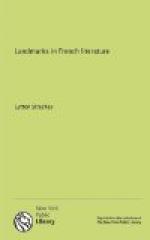The main conception of the fables was based upon the combination of two ideas—that of the stiff dry moral apologue of AEsop, and that of the short story. By far the most important of these two elements was the latter. With the old fabulists the moral was the excuse for the fable; with La Fontaine it was the other way round. His moral, added in a conventional tag, or even, sometimes, omitted altogether, was simply of use as the point of departure for the telling of a charming little tale. Besides this, the traditional employment of animals as the personages in a fable served La Fontaine’s turn in another way. It gave him the opportunity of creating a new and delightful atmosphere, in which his wit, his fancy, his humour, and his observation could play at their ease. His animals—whatever injudicious enthusiasts may have said—are not real animals; we are no wiser as to the true nature of cats and mice, foxes and lions, after we have read the Fables than before. Nor, on the other hand, are they the mere pegs for human attributes which they were in the hands of AEsop. La Fontaine’s creatures partake both of the nature of real animals and of human beings, and it is precisely in this dual character of theirs that their fascination lies. In their outward appearance they are deliciously true to life. With the fewest of rapid strokes, La Fontaine can raise up an unmistakable vision of any beast or bird, fish or reptile, that he has a mind to—
Un jour sur ses long pieds
allait je ne sais ou
Le heron au long bec emmanche
d’un long cou.
Could there be a better description? And his fables are crowded with these life-like little vignettes. But the moment one goes below the surface one finds the frailties, the follies, the virtues and the vices of humanity. And yet it is not quite that. The creatures of La Fontaine’s fantasy are not simply animals with the minds of human beings: they are something more complicated and amusing; they are animals with the minds which human beings would certainly have, if one could suppose them transformed into animals. When the young and foolish rat sees a cat for the first time and observes to his mother—
Je le crois fort sympathisant
Avec messieurs les rats:
car il a des oreilles
En figure aux notres pareilles;
this excellent reason is obviously not a rat’s reason; nor is it a human being’s reason; the fun lies in its being just the reason which, no doubt, a silly young creature of the human species would give in the circumstances if, somehow or other, he were metamorphosed into a rat.




